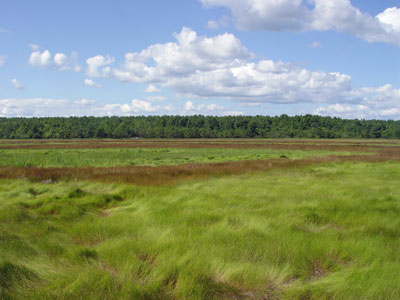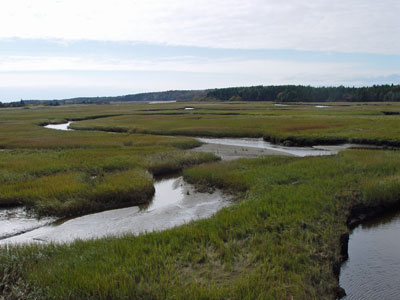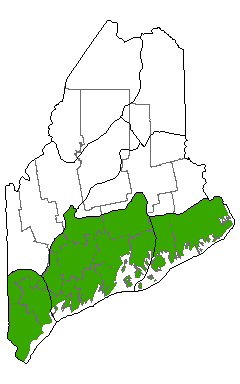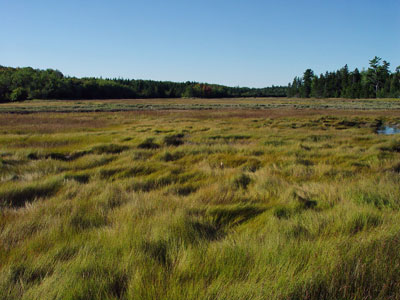DACF Home → Bureaus & Programs → Maine Natural Areas Program → Communities, Plants, and Animals → Natural Community Fact Sheets → Salt-hay Saltmarsh
Printer Friendly Fact Sheet - 740 KB pdf Get a free copy of Adobe Acrobat Reader)
Salt-hay Saltmarsh
Scientific Name: Spartina Saltmarsh; State Rank: S3

- Community Description
- Soil and Site Characteristics
- Diagnostics
- Similar Types
- Conservation, Wildlife and Management Considerations
- Distribution
- Characteristic Plants
- Associated Rare Plants
- Associated Rare Animals
- Examples on Conservation Lands You Can Visit
Community Description: These tidal marshes consist of expanses of saltmeadow cordgrass, smooth cordgrass, and/or saltmarsh rush. Shrubs are virtually absent, and the herbaceous cover is usually >85%. Much of the marsh is high marsh, where saltmeadow cordgrass forms meadows, and where saltmarsh rush may be dominant at slightly higher elevations. In the low marsh, along creeks or at elevations just below mean high water, smooth cordgrass is abundant. Salt pannes with abundant seashore saltgrass may dot the high marsh; goosetongue may also be locally common. Sea lavender and seaside goldenrod are often found at the upper tidal fringe. The dominant species typically form bands corresponding to tidal inundation zones. Back to top.

Soil and Site Characteristics: Salt-hay saltmarshes are typically associated with beach-dune systems (back barrier marshes) or the outer reaches of estuaries (finger marshes). They are extensive along both sides of the tidal river or stream. The extensive high marsh zone is only flooded by above average tides. Salt marsh peat is typically several meters thick. Most are large (>10 acres), but they occasionally occur as smaller pockets along estuaries and coves. Back to top.
Diagnostics: These types are coastal back dune marshes, or near the outer reaches of estuaries, with saltmeadow cordgrass, smooth cordgrass, and saltmarsh rush totaling >35% cover, often in bands. The high marsh is well developed. Back to top.
Similar Types: Mixed Saltmarshes may also have cordgrasses and/or saltmarsh rush abundant, but will also have a mix of other co-dominant species, which tend to occur in patches rather than tidal zones; they are typically smaller, often less than 5 acres, and tend to occur farther upstream in estuaries or in smaller, more protected pockets. Brackish Tidal Marshes, which also occur farther upstream in estuaries, lack saltmarsh cordgrasses. Back to top.
Conservation, Wildlife and Management Considerations: Few of the larger saltmarshes in Maine are pristine, with some having been filled and nearly all ditched at one time or another. With wetland protection in recent decades many of those that remain are reverting to a more natural hydrologic regime. Many of the remaining high quality Spartina Saltmarshes are on public land or private conservation land. Maintenance of appropriate wetland buffers can help reduce degradation that could result from adjacent land uses.
Saltmarshes are important nesting habitat for Nelson’s sharp-tailed sparrow, seaside sparrow, and the rare saltmarsh sharp-tailed sparrow. These wetlands also provide foraging habitat for a large number of wadingbirds and shorebirds, including rare species such as the laughing gull, black-crowned night-heron, and least tern. The big bluet, a rare damselfly, inhabits saltmarsh ponds with emergent vegetation in southern Maine. Back to top.
Distribution:Coastal Maine, mostly southwest of Merrymeeting Bay ( Eastern Broadleaf Forest Province); sporadic and less well developed downeast. Extends southward along the Atlantic coast. Landscape Pattern: Large Patch. Back to top.


Characteristic Plants: These plants are frequently found in this community type. Those with an asterisk are often diagnostic of this community.
- Herb
- Alkali bulrush
- Common arrow-grass*
- Goosetongue*
- Purple-stemmed aster
- Saltmarsh rush*
- Saltmeadow cordgrass*
- Sea milkwort*
- Seashore saltgrass*
- Seaside goldenrod*
- Smooth cordgrass*
- Wire rush*
- Big bluet
- Black-crowned night-heron
- Laughing gull
- Least tern
- Saltmarsh sharp-tailed sparrow
- Short-eared owl
Examples on Conservation Lands You Can Visit
| Example | County |
|---|---|
| Bass Harbor Marsh, Acadia National Park | Hancock Co. |
| Morse Mountain Preserve | Sagadahoc Co. |
| Rachel Carson National Wildlife Refuge | York Co. |
| Reid State Park | Sagadahoc Co. |
| Scarborough Marsh Wildlife Management Area | Cumberland Co. |
